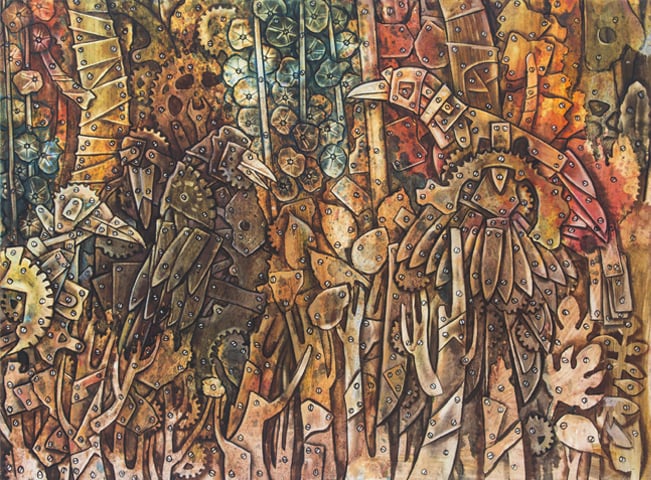In ancient Egypt, the “Ba” or an individual’s personality was depicted in the form of a bird with a human head. This mythical bird had the ability to travel between life and afterlife. Such was its power and potency that, in other ancient cultures and civilisations, mythical birds came to represent spirituality, resurrection and even auspiciousness. E.H. Aitken, an Anglo-Indian writer of natural history could barely contain his excitement as he ascribed human qualities to birds, when he wrote in The Naturalist on the Prowl, “You may live in the same garden with a little bird and meet it many times a day, and never know that it is married and has a family.”
Modernity has changed the way we experience and reference animals and birds now. The wonder and veneration accorded to birds and animals in nature has waned away. We are teetering between warnings raised by environmentalists about ecological imbalances and the extinction of various natural species. Artists, too, are attempting to respond to this new, albeit bleak, worldview in their own way.
A recent show at O Art Space in Lahore, titled Wondering Birds and featuring sculptures and paintings by British-Irani artist Dr Mohsen Keiany ,explores the depiction of nature in our apocalyptic times. Dr Keiany has already exhibited these works at the Karachi Beinnale held recently this year.
What would birds look like in a dystopian world? How would our imagination recall them in a world devoid of nature? The artist has painstakingly constructed the sculptural forms of various bird species from junk and scrap metal. Sixteen sculptures, in varying shapes and sizes, engage the viewer in the gallery space. Nuts, bolts, ageing rivets, metal knives and corroding beaks made of scissors are all painstakingly welded to construct the anatomy of different birds. The study is meticulous, with bird feathers transplanted by the tactile, cold and hard surface of various machine forms. His paintings, executed in the colours of rust, patina and ageing metallic tones, contain similar images of birds that resemble machines.
British-Irani artist Mohsen Keiany explores the depiction of nature in apocalyptic times
In his artist’s statement, Dr Keiany bemoans the loss of nature in his village which has become a town infested with litter and invaded by technology. He associates birds with spirituality, fables and stories, such as The Conference of Birds.

The gradual erosion of such erudition, culture and value systems is mirrored in his featherless birds devoid of colour, lustre and constructed from discarded debris. Perhaps it is also his genuine anxiety and fear about the future that makes his sculptures of “robotic birds” unnerving. They appear both uncanny and life-like at the same time. Are they already referencing our paranoias and fears shaped by popular culture and informed by dystopian cinema which shows worlds that feature last-creatures-on-earth (think of Disney’s Wall-E, the last robot on earth cleaning up our mess) in the form of robots? The sad irony is that the presence of these “robotic” bird sculptures in Lahore during “smog season” is rather appropriate; their “ka” or “life force”, as imagined by the ancient Egyptians, could easily and most suitably conjure itself in our smog-filled air today.
In 1963, Alfred Hitchcock made The Birds, which featured swarms of birdlife mysteriously attacking a town and its inhabitants until they decimate it. In hindsight, one can argue that, for the viewer in 2018, the film carries a prescient warning of ecological disasters to come. In an interview, Hitchcock talked about the symbolism and role of the birds, saying, “They are the revolt of nature against mankind. We take too many things for granted.”
Perhaps Dr Keiany’s birds too, with their unnatural anatomy and sinister forms carry the same message.
“Wondering Birds” was exhibited at O Art Space in Lahore from November 26th to December 3rd, 2019
Published in Dawn, EOS, December 15th, 2019
















































Dear visitor, the comments section is undergoing an overhaul and will return soon.